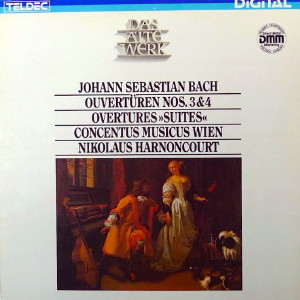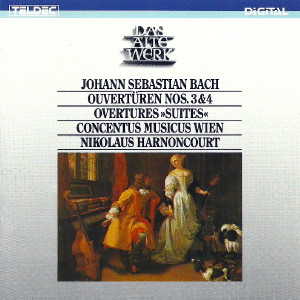 |
1 LP -
6.43052 AZ - (p) 1985
|
 |
| 1 CD -
8.43052 ZK - (p) 1985 |
|
| Johann
Sebastian Bach (1685-1750) |
|
|
|
|
|
|
|
| Ouvertüre (Suite) Nr. 3
D-dur, BWV 1068 |
|
23' 45" |
A |
| - Ouverture |
11' 40" |
|
|
- Air
|
4' 39" |
|
|
| - Gavotte
I alternativement / Gavotte II |
3' 40" |
|
|
| - Bourrée |
1' 10" |
|
|
| - Gigue |
2' 36" |
|
|
| Ouvertüre (Suite) Nr. 4
D-dur, BWV 1069 |
|
24' 09" |
B |
- Ouverture
|
13' 06" |
|
|
| - Bourrée
I alternativement / Bourrée II |
2' 17" |
|
|
| - Gavotte |
1' 44" |
|
|
| - Menuet I alternativement /
Menuet II |
4' 05" |
|
|
- Réjouissance
|
2' 57" |
|
|
|
|
|
|
CONCENTUS MUSICUS
WIEN (mit
Originalinstrumenten)
|
|
| -
Friedemann Immer, Naturtrompete |
-
Peter Schoberwalter, Violine |
|
| -
Richard Rudolf, Naturtrompete |
-
Andrea Bischof, Violine |
|
| -
Hermann Schober, Naturtrompete |
-
Karl Höffinger, Violine |
|
| -
Kurt Hammer, Pauken |
-
Walter Pfeiffer, Violine |
|
| -
Jürg Schaeftlein, Oboe |
-
Helmut Mitter, Violine |
|
| -
Valerie Darke, Oboe |
-
Kurt Theiner, Viola |
|
| -
Marie Wolf, Oboe (BWV 1069) |
-
Josef de Sordi, Viola |
|
| -
Milan Turković, Barockfagott |
-
Rudolf Leopold, Violoncello |
|
| -
Alice Harnoncourt, Violine |
-
Eduard Hruza, Violone |
|
| -
Erich Höbarth, Violine |
-
Herbert Tachezi, Cembalo |
|
| -
Anita Mitterer, Violine |
|
|
|
|
| Nikolaus
Harnoncourt, Leitung |
|
|
|
Luogo
e data di registrazione
|
| Casino Zögernitz,
Vienna (Austria) - dicembre
1983 |
|
Registrazione
live / studio
|
| studio |
Producer
/ Engineer
|
-
|
Prima Edizione CD
|
| - Teldec
"Das Alte Werk" - 8.43052 ZK - (1 cd) -
47' 54" - (p) 1985 - DDD |
Prima
Edizione LP
|
| -
Teldec "Das Alte Werk" - 6.43052 AZ - (1
lp) - 47' 54" - (p) 1985 -
Digital |
|
|
Notes
|
The musical term suite
means a row, a sequence of pieces, in
fact primarily of
dances. Bach himself, ist must be
said, never named his suites thus, but
used the name of the weighty
introductory movement, "Ouverture",
as the tltle of the entire
work. Nevertheless, they are genuine
suites which count among the last
works of this ancient category.
Through the extension of the
dominating introductory movement, the
overture, to half the length of the
entire work, Bach
elevated his suites from the sphere of
light “table music” and formed them
into genuine works of
“worldly” festive music. The elements
of greatness and splendour are
underlined by the constitution of the
orchestra in the 1st,
3rd and 4th suites. The dances and
characteristic pieces follow the
overture according to a brilliant plan
of dramatic significance.
The structure of the Third Suite is
more easily grasped than that of the
other suites, alone on account of the
smaller number of movements. After the
manificently energetic overture there
follows, as the heart of the work, the
unique Air. It is an
“Italian” adagio which Bach has placed
as the only movement reminiscent of
the Vivaldi style in this “Fench"
environment. This stylistic contrast
lends its far-soaring melody an added
magic. The three French dance
movements that follow again offer an
ingenious intensification of tempo and
expression: from the aristocratic
Gavotte there springs, as it were,
the fiery Bourrée, and the work
then closes with a fourther intensification
in the energetic
Gigue. In this Gigue, the italian and
French forms of the dance, as
explained above, are blended in a
wonderful manner.
The 1st violins and
the oboes run along
in quavers, it is true, but since
these are not led in virtuoso leaps
and brolten chords as in the ltalian
gigue, but in small intervals - furthermore
being slurred in
half-bars - thc soloist bravura
characteristic of the Italian gigue is
tamed to produce a finale with wide
melodic curves in the upper part
rising above the dance-like,
forward-urging foundation of the
middle parts and the bass.
Thc Fourth Suite is the only one
already to include an allegro section
in dance character in the overture.
The character and rhythm of a gigue
are built into the form of the fugato
Allegro. The sequence of dances is not
laid out so as to create an
intensification here, but as a
continual calming down. It
begins with a passionate Bourrée; the
Gavotte that follows is both one
degree more moderate in tempo and one
stage more noble in character.
In the Minuet, which is still more
calm in tempo, courtly elegance and
restraint dominate again. The sequence
of these threemovements thus shows not
only a calming of the passion, a
moderating of the tempo, but more
still a gradual becoming nobler
expressed in ever greater self-control.
The Réjouissance is here simply the
necessary joyful finale, intended to
diiniss the listener gaily after the
suite.
|
|
Nikolaus
Harnoncourt (1929-2016)
|

|

|
|